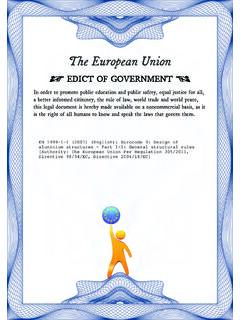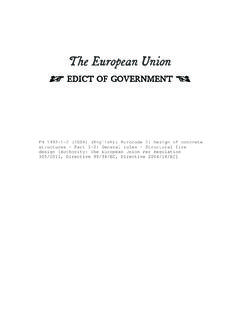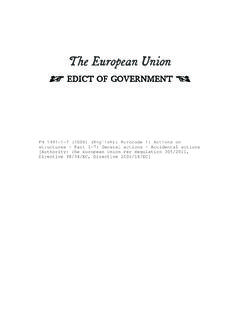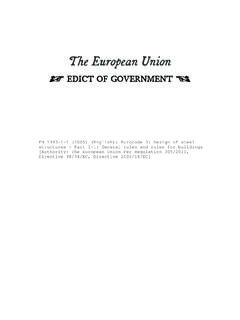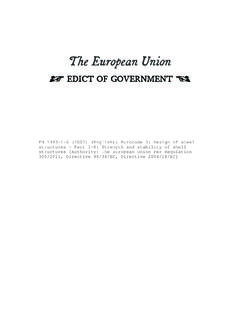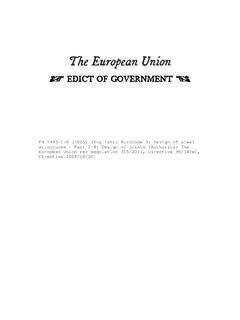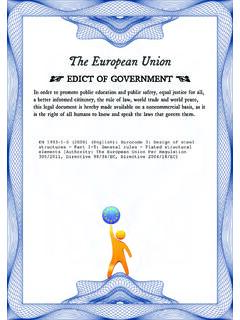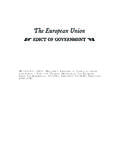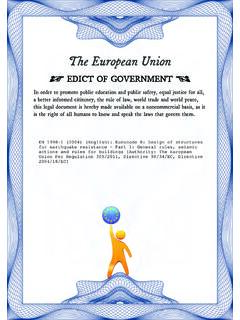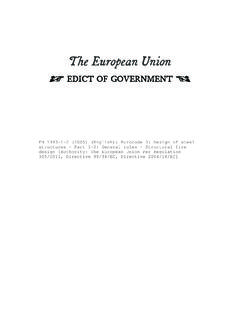Transcription of EN 1992-1-2: Eurocode 2: Design of concrete structures ...
1 The European UnionIn order to promote public education and public safety, equal justice for all, a better informed citizenry, the rule of law, world trade and world peace, this legal document is hereby made available on a noncommercial basis, as it is the right of all humans to know and speak the laws that govern them. EDICT OF GOVERNMENT EN 1992-1-2 (2004) (English): Eurocode 2: Design of concretestructures - Part 1-2: General rules - Structural firedesign [Authority: The European Union Per Regulation305/2011, Directive 98/34/EC, Directive 2004/18/EC]EUROPEAN STANDARD EN 1992-1-2 NORME EUROPEENNE EUROpAISCHE NORM December 2004 ICS ; ; Supersedes ENV 1992-1-2: 1995 Incorporating corrigendum July 2008 English version Eurocode 2: Design of concrete structures - Part 1-2: General rules - Structural fire Design Eurocode 2: Calcul des structures en beton Partie 1-2: Regles generales Calcul du comportement au feu Eurocode 2: Planung von Stahlbeton-und Spannbetontragwerken TeiI1-2: Allgemeine Regeln -Tragwerksbemessung fOr den Brandfall This European Standard was approved by CEN on 8 July 2004.
2 CEN members are bound to comply with the CEN/CENELEC Internal Regulations which stipulate the conditions for giving this European Standard the status of a national standard without any alteration. Up-to-date lists and bibliographical references concerning such national standards may be obtained on application to the Central Secretariat or to any CEN member. This European Standard exists in three official versions (English, French, German). A version in any other language made by translation under the responsibility of a CEN member into its own language and notified to the Central Secretariat has the same status as the official versions. CEN members are the national standards bodies of Austria, Belgium, Cyprus, Czech Republic, Denmark, Estonia, Finland, France, Germany, Greece, Hungary, Iceland, Ireland, Italy, Latvia, Lithuania, Luxembourg, Malta, Netherlands, Norway, Poland, Portugal, Slovakia, Slovenia, Spain, Sweden, Switzerland and United Kingdom.
3 EUROPEAN COMMITTEE FOR STANDARDIZATION COMITE EUROPEEN DE NORl\1 ALrSATlON EUROpAISCHES KOMITEE FUR NORMUNG Management Centre: rue de Stassart, 36 B 1050 Brussels 2004 CEN All rights of exploitation in any form and by any means reserved worldwide for CEN national Members. Ref. No. EN 1992-1-2: 2004: E BS EN 1992-1-2: 2004 EN 1992-1-2: 2004 (E) Contents List 1 General Scope Scope of Eurocode 2 Scope of Part 1-2 of Eurocode 2 Normative references Assurnptions Distinctions between principles and application rules Definitions Symbols Supplementary symbols to EN 1992-1-1 Supplementary subscripts to EN 1992-1-1 2 Basis of Design Requirements General Nominal fire exposure Parametric fire exposure Actions Design values of material properties Verification nlethods General Member analysis Analysis of part of the structure Global structural analysis 3 Material properties General Strength and defornlation properties at elevated temperatures General concrete concrete under compression Tensile strength Reinforcing steel Prestressing steel Thermal and physical properties of concrete with siliceous and calcareous aggregates Thermal elongation Specific heat Thermal conductivity Thermal
4 Elongation of reinforcing and prestressing steel 4 Design procedures General Simplified calculation nlethod 2 General Temperature profiles Reduced cross-section Strength reduction General concrete Steel Advanced calculation methods General Thermal response Mechanical response Validation of advanced calculation models Shear, torsion and anchorage Spalling Explosive spalling Falling off of concrete Joints Protective layers 5 Tabulated data Scope General Design rules Columns General [ ) Method A Method B @il Walls [ ) Non load bearing compartmentation walls @il Load-bearing solid walls Fire walls Tensile members Beams General Simply supported beams Continuous beams Beams exposed on all sides Slabs General Simply supported solid slabs Continuous solid slabs Flat slabs Ribbed slabs 6 High strength concrete (HSC) General Spalling Thermal properties Structural Design Calculation of load-carrying capacity Simplified calculation method Columns and walls Beams and slabs Tabulated data BS EN 1992-1-2: 2004 EN 1992-1-2: 2004 (E) 3 BS EN 1992-1-2: 2004 EN 1992-1-2: 2004 (E) Informative annexes A Temperature profiles B Simplified calculation methods C Buckling of columns under fire conditions D Calculation methods for shear, torsion and anchorage E Simplified calculation method for beams and slabs Foreword This European Standard EN 1992-1-2 , " Design of concrete structures - Part 1-2 General rules -Structural fire Design ", has been prepared by Technical Committee CEN/TC250 "Structural Eurocodes", the Secretariat of which is held by BSI.]]
5 CEN/TC250 is responsible for all Structural Eurocodes. This European Standard shall be given the status of a National Standard, either by publication of an identical text or by endorsement, at the latest by June 2005, and conflicting National Standards shall be withdrawn at latest by March 2010. This European standard supersedes ENV 1992-1-2: 1995. According to the CEN-CENELEC Internal Regulations, the National Standard Organisations of the following countries are bound to ilTlplement these European Standard: Austria, Belgium, Cyprus, Czech Republic, Denmark, Estonia, Finland, France, Germany, Greece, Hungary, Iceland, Ireland, Italy, Latvia, Lithuania, Luxembourg, Malta, Netherlands, Norway, Poland, Portugal, Slovakia, Slovenia, Spain, Sweden, Switzerland and United Kingdom. Background of the Eurocode programme In 1975, the Commission of the European Community decided on an action progralTlme in the field of construction, based on article 95 of the Treaty.
6 The objective of the programme was the elimination of technical obstacles to trade and the harmonisation of technical specifications. Within this action programme, the Commission took the initiative to establish a set of harmonised technical rules for the Design of construction works which, in a first stage, would serve as an alternative to the national rules in force in the Member States and, ultimately, would replace them. For fifteen years, the Commission, with the help of a Steering Committee with Representatives of Member States, conducted the development of the Eurocodes programme, which led to the first generation of European codes in the 1980s. In 1989, the Commission and the Member States of the EU and EFTA decided, on the basis of an agreement1 between the Commission and CEN, to transfer the preparation and the 1 Agreement between the Commission of the European Communities and the European Committee for Standardisation (CEN) concerning the work on EUROCODES for the Design of building and civil engineering works (BC/CEN/03/89).
7 4 BS EN 1992-1-2: 2004 EN 1992-1-2: 2004 (E) publication of the Eurocodes to the CEN through a series of Mandates, in order to provide them with a future status of European Standard (EN). This links de facto the Eurocodes with the provisions of all the Council's Directives and/or Commission's Decisions dealing with European standards ( the Council Directive 89/1 06/EEC on construction products - CPO - and Council Directives 93/37/EEC, 92/50/EEC and 89/440/EEC on public works and services and equivalent EFTA Directives initiated in pursuit of setting up the internal market). The Structural Eurocode programme comprises the following standards generally consisting of a number of Parts: EN 1990 EN 1991 EN 1992 EN 1993 EN 1994 EN 1995 EN 1996 EN 1997 EN 1998 EN 1999 Eurocode : Eurocode 1: Eurocode 2: Eurocode 3: Eurocode 4: Eurocode 5: Eurocode 6: Eurocode 7: Eurocode 8: Eurocode 9: Basis of Structural Design Actions on structures Design of concrete structures Design of steel structures Design of composite steel and concrete structures Design of timber structures Design of masonry structures Geotechnical Design Design of structures for earthquake resistance Design of aluminium structures Eurocode standards recognise the responsibility of regulatory authorities in each Member State and have safeguarded their right to determine values related to regulatory safety matters at national level where these continue to vary from State to State.
8 Status and field of application of Eurocodes The Mernber States of the EU and EFTA recognise that Eurocodes serve as reference documents for the following purposes: as a means to prove compliance of building and civil engineering works with the essential requirements of Council Directive 89/106/EEC, particularly Essential Requirement N 1 -Mechanical resistance and stability - and Essential Requirement N 2 Safety in case of fire; as a basis for specifying contracts for construction works and related engineering services; as a framework for drawing up harmonised technical specifications for construction products (ENs and ETAs) The Eurocodes, as far as they concern the construction works themselves, have a direct relationship with the Interpretative Documents2 referred to in Article 12 of the CPO, although they are of a different nature from harmonised product standards3. Therefore, technical aspects arising from the Eurocodes work need to be adequately considered by CEN Technical 2 According to Art.
9 Of the CPD, the essential requirements (ERs) shall be given concrete form in interpretative documents for the creation of the necessary links between the essential requirements and the mandates for harmonised ENs and ETAGs/ET As. 3 According to Art. 12 of the CPD the interpretative documents shall : a) give concrete form to the essential requirements by harmonising the terminology and the technical bases and indicating classes or levels for each requirement where necessary; b) indicate methods of correlating these classes or levels of requirement with the technical specifications, methods of calculation and of proof, technical rules for project Design , etc. , c) serve as a reference for the establishment of harmonised standards and guidelines for European technical approvals. The Eurocodes, de facto, playa similar role in the field of the ER 1 and a part of ER 2. 5 BS EN 1992-1-2: 2004 EN 1992-1-2: 2004 (E) Comnlittees and/or EOTA Working Groups working on product standards with a view to achieving full compatibility of these technical specifications with the Eurocodes.
10 The Eurocode standards provide common structural Design rules for everyday use for the Design of whole structures and COITlpOnent products of both a traditional and an innovative nature. Unusual forms of construction or Design conditions are not specifically covered and additional expert consideration will be required by the designer in such cases. National Standards implementing Eurocodes The National Standards implementing Eurocodes will comprise the full text of the Eurocode (including any annexes), as published by CEN, which may be preceded by a National title page and National foreword, and may be followed by a National Annex. The National Annex may only contain information on those parameters which are left open in the Eurocode for national choice, known as Nationally DeterITlined Parameters, to be used for the Design of buildings and civil engineering works to be constructed in the country concerned, : -values and/or classes where alternatives are given in the Eurocode , -values to be used where a symbol only is given in the Eurocode , -country specific data (geographical, climatic, etc.)
